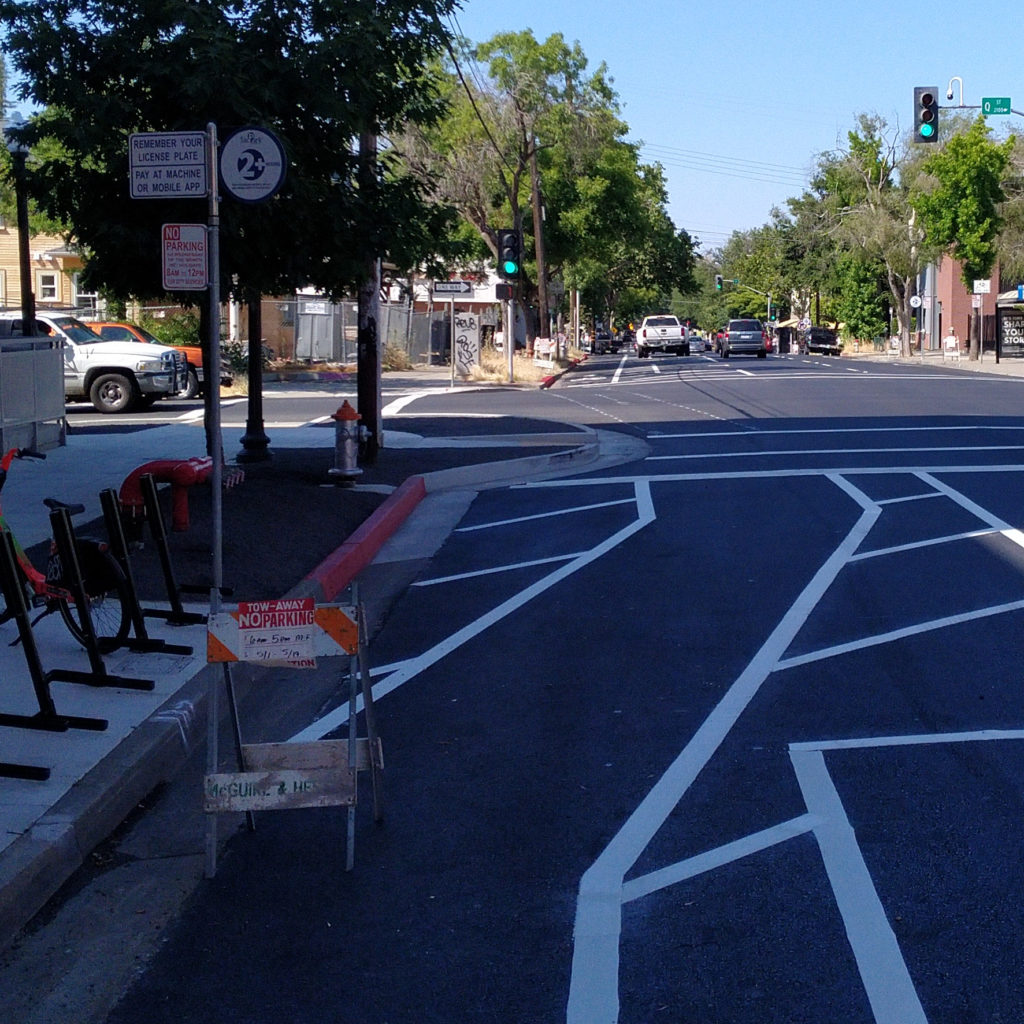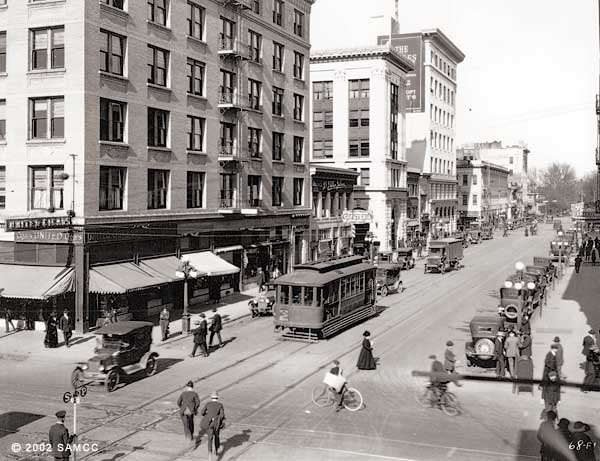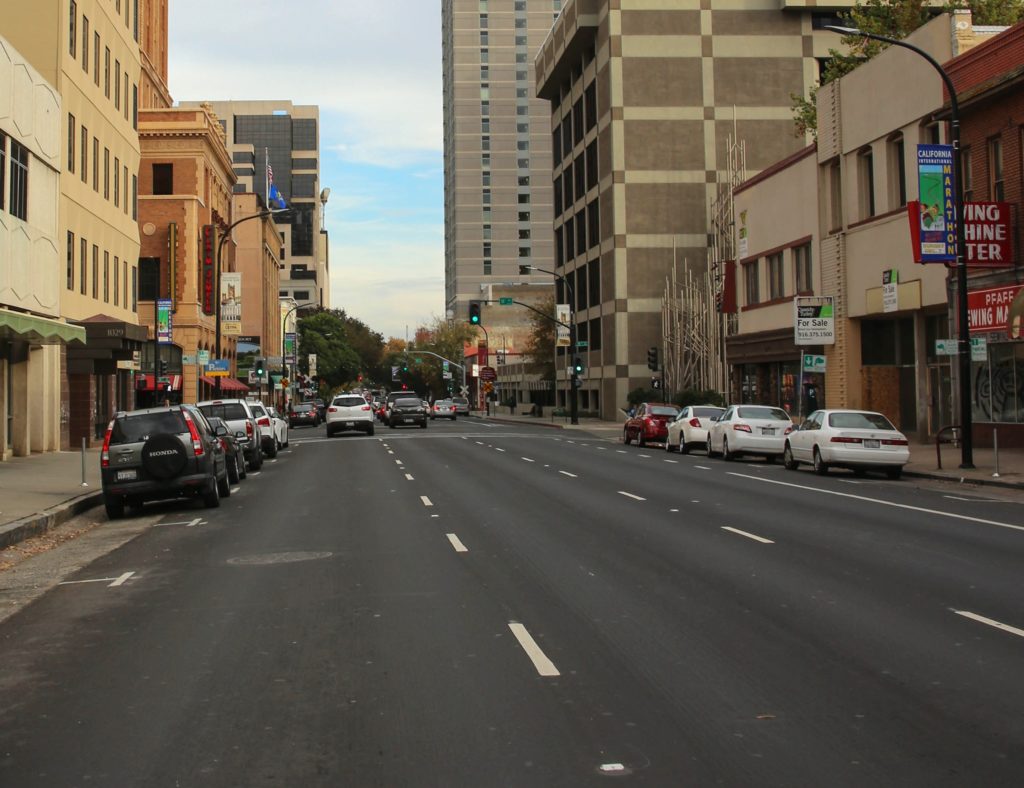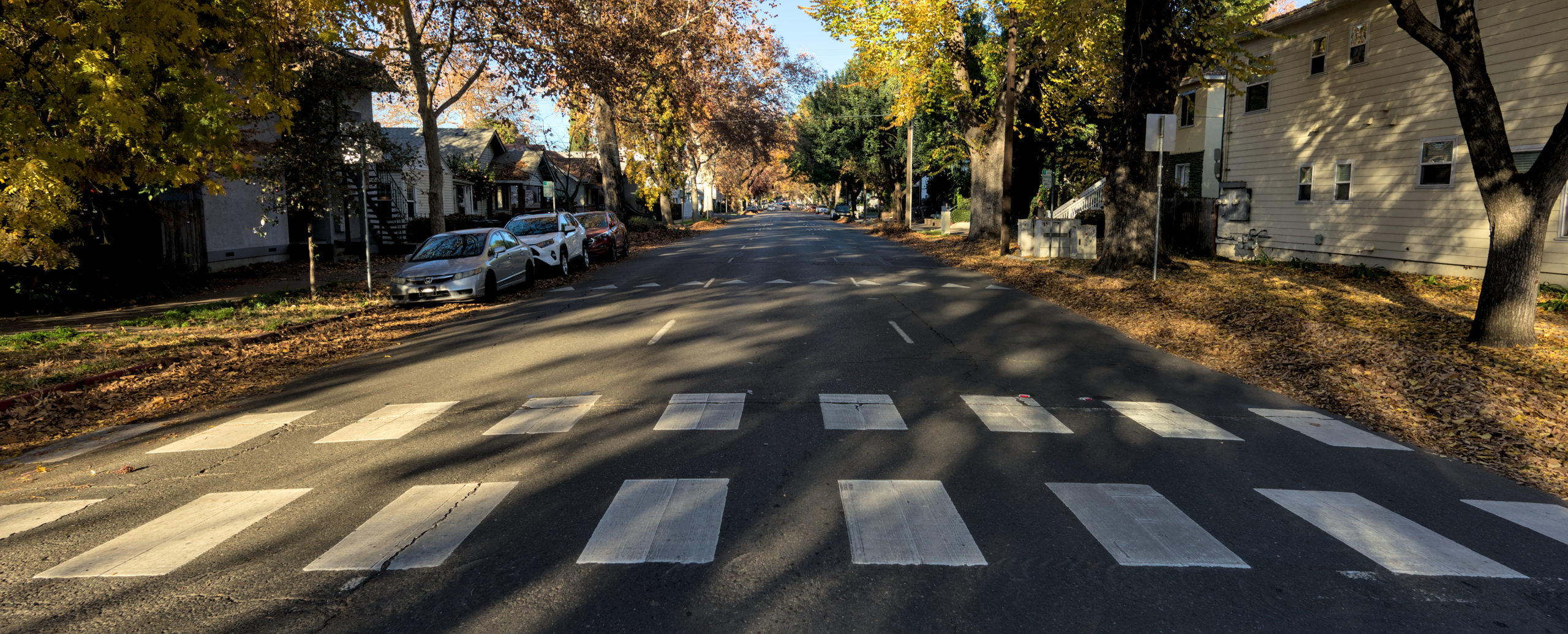
See our Instagram post here!
One-way streets were first introduced to increase the flow of cars into downtowns, a direct result of white flight and the Suburban Experiment. They had a significant negative impact on health and safety back then, and they continue to do so today. Fortunately, advocates in Sacramento have successfully worked with the City to revert some of these one-way monstrosities within the central city over the last few decades. As Strong SacTown, we support this trend towards a more traditional street design so that Sacramento can be safer, more pleasant, productive, and people-oriented.
A product of the Suburban Experiment
During the 1950s in the U.S., booming development of post-streetcar, car-centric suburbs combined with “white flight” and “urban renewal” would soon present a problem for commuters who would otherwise experience heavy traffic congestion trying to reach downtown jobs and amenities. Placating these new suburban dwellers meant finding ways to accommodate mass movement of cars into and throughout downtowns where jobs were located.
Traffic engineers borrowed many features of highway design to reduce complexity and points of conflict that could slow traffic. Perhaps the most prominent of those features was the introduction of the one-way street. In 1956, Sacramento traffic engineer D. Jackson Faustman wrote to the American Society of Civil Engineers:
“The phenomenal increase in motor-vehicle transportation emphasizes the need for making the most efficient use of existing streets and highways. The one-way street offers an inexpensive, effective tool for better urban street use. The advantages of one-way streets include (a) increased traffic capacity, (b) relatively low cost, (c) reduction in accidents, (d) ease of accomplishment, (e) higher operating speeds, and (f) flexibility in meeting changing traffic patterns. These gains far outweigh the disadvantages of longer travel for some traffic, confusion to strangers, and a possible disruptive effect on certain types of business.“
https://ascelibrary.org/doi/10.1061/TACEAT.0007303
Like many other traffic engineers in the 1950s, Faustman was eager to implement one-way street conversions. He was so fixated on the improvements to traffic capacity and vehicle speed that he was unable or unwilling to recognize how one-ways disadvantage the safety for people outside of cars, and he downplayed their true impact to local businesses and their true monetary cost to implement.
Sacramento fed fuel to that fire over the next two decades by pioneering a model of financing large projects by issuing bonds secured by local tax increases, in addition to receiving millions more in federal grants. “Low cost” is truly a relative term when money is no object. The large-scale restructuring of streets also coincided with a period of white flight and urban renewal, causing the loss of the pre-existing local constituency that could self-organize and resist the changes. In downtown Sacramento alone, over 350 businesses and 92% of residents were displaced and their homes demolished from 1950 to 1970, minimizing any chance of opposition where most one-way streets were planned. The city’s historic dedication to urban renewal and total adoption of the Suburban Experiment was perfectly aligned with the intentions of one-ways, so Faustman had it his way the next two decades.
One-Way Streets Today
Throughout the 1990s and 2000s, residents of Midtown and surrounding neighborhoods continuously advocated for the conversion of many one-ways back to two-ways. Today, only 30% of streets in the central city remain one-way.
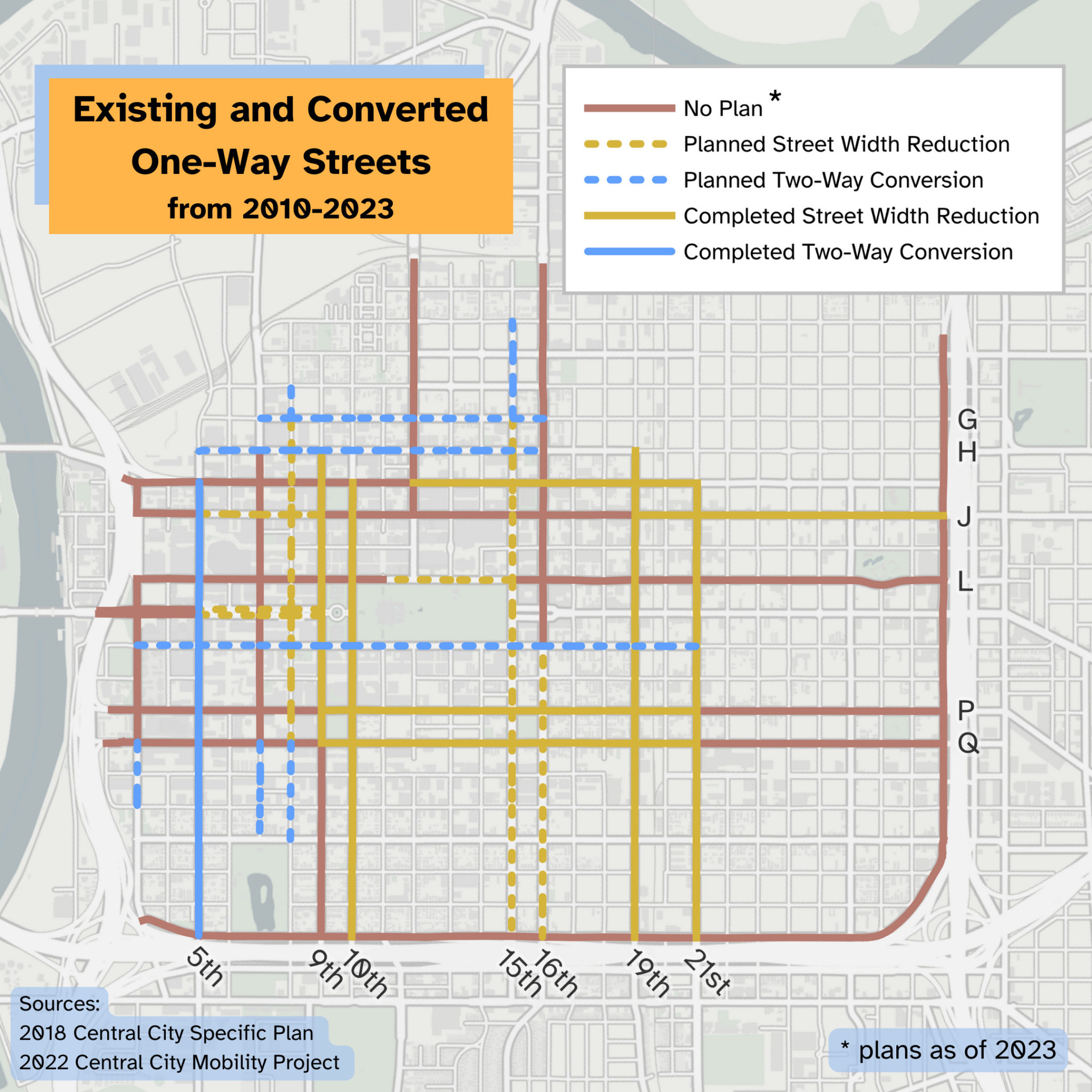
Crashes on One-Way Streets
Within an urban setting, one-way streets often sacrifice pedestrian and cyclist safety for car traffic capacity. They tend to be designed to encourage higher speeds; high speeds are the primary determining factor in crash severity. Furthermore, they tend to have long crosswalks which increases the amount of time pedestrians are vulnerable to high-speed traffic while crossing.
However, don’t just trust my conjecture; trust measured outcomes. According to the Transportation Injury Mapping System (TIMS), here are all the cases from 2012-2022 where cars crashed into a pedestrian or cyclist within the central city:
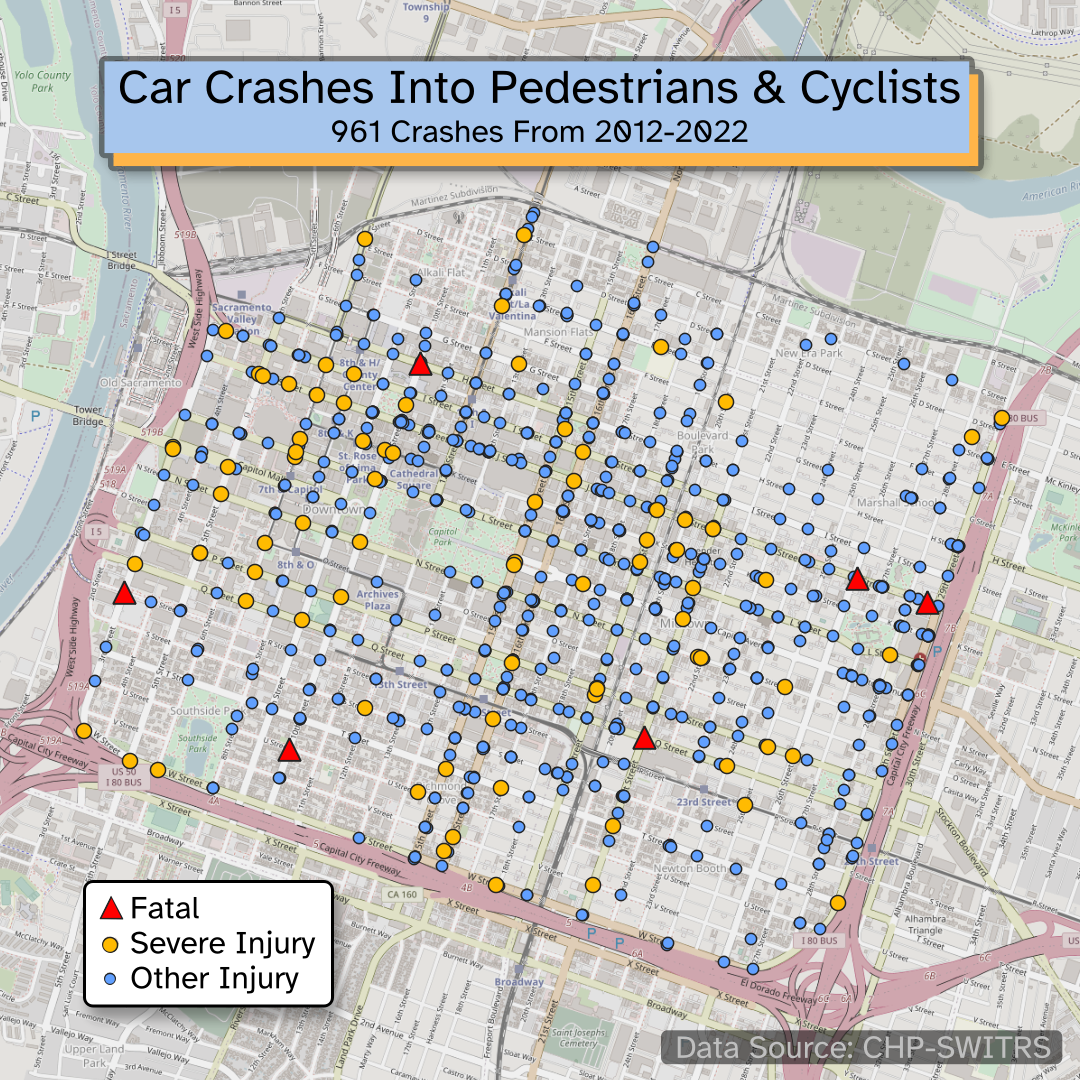
Yep, that’s 961 crashes over an 11 year period, or one car crash every 4.2 days causing injury or death to a pedestrian or cyclist within the central city alone. That also doesn’t count crashes where police were not called to the scene, so it is safe to say that there are actually more than 961 crashes from 2012-2022.
In order to understand the role that one-way streets play in safety, I counted which crashes occurred on one-way streets and which did not, and also categorized data by crash severity. What I discovered was equally stark:

One-way streets make up only 30% of the central city, yet they are the sites of over 75% of all car crashes that injure pedestrians and cyclists. Furthermore, the higher the injury severity, the more likely the crash occurred on a one-way. 100% of car crashes causing death of a pedestrian or cyclist occurred on one-way streets.
Clearly, one-way streets, or qualities of their design within the grid, are more dangerous for people outside of cars. Did the traffic engineers anticipate these deadly outcomes? Maybe, maybe not, but I’m willing to bet that pedestrian safety was not a consideration when Faustman wrote that the “gains [of one-ways] far outweigh the disadvantages.”
Noise Pollution on One-Way Streets
Noise is a part of everyday life, from the clanging of silverware from a nearby cafe to the banter between people walking by. Passing dogs jingle their tags, leaves rustle, and birds chirp from above. This combination of urban and natural sounds is too often masked by unwanted noise: the constant hum of passing cars.
According to the city itself: “Vehicles are the primary source of noise in Sacramento.” This fact is obvious to anybody who lives within 3-4 blocks of a highway, but also 1-2 blocks away from a one-way street:
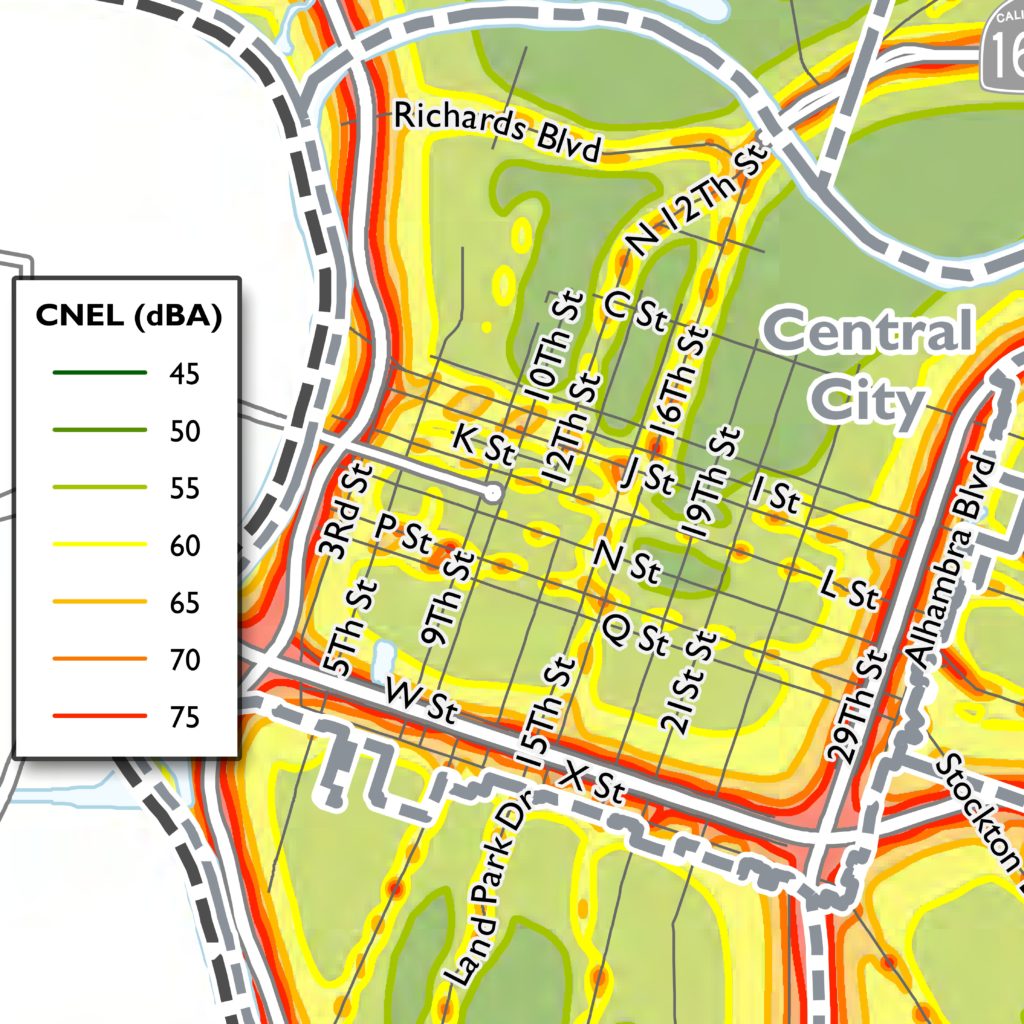
Exposure to traffic noise is associated with cardiovascular risk factors, comprising “increased blood pressure and dyslipidemia, increased blood viscosity and blood glucose, and activation of blood clotting factors.” Furthermore, exposure at a young age is linked to higher dementia risk, especially above 45 dB (yellow to red areas on the noise profile above). In a study from Geneva in 2006, it was found that for every 3 years of life lost to car-induced air pollution, 1 year is lost to car-induced noise pollution.
Unfortunately, electric cars aren’t going to save us here, since most noise from cars traveling at least 30mph comes from tires and wind, not from the engine. Furthermore, at lower speeds electric vehicles are required to project synthetic sounds, ironically for safety.
Are One-Way Streets Inherently Dangerous?
Not exactly. City requirements for high vehicle speeds and high-capacity travel, and an uncompromising focus on achieving these requirements, set up traffic engineers to create dangerous monstrosities of urban one-ways that more closely resemble Stroads than streets. Here are ways that traffic engineers in Sacramento have historically encouraged high speeds and high vehicle capacity:
- Add multiple lanes of travel (up to 4 in some cases).
- Install traffic lights instead of stop signs, or two-way stops instead of four-way stops.
- These impediments for pedestrians can lead them to cross at potentially dangerous times.
- Remove parking lanes (replaced with travel lanes) to eliminate potential vehicle slow-downs.
- Narrow sidewalks to widen travel lanes.
The end result is a pedestrian crossing distance which is longer (due to vehicle capacity requirements) and more deadly when crashes occur (due to vehicle speed requirements). The following two Sacramento-based examples compare an unmitigated one-way street to one that has been improved (in 2018) for the safety of people outside of cars:
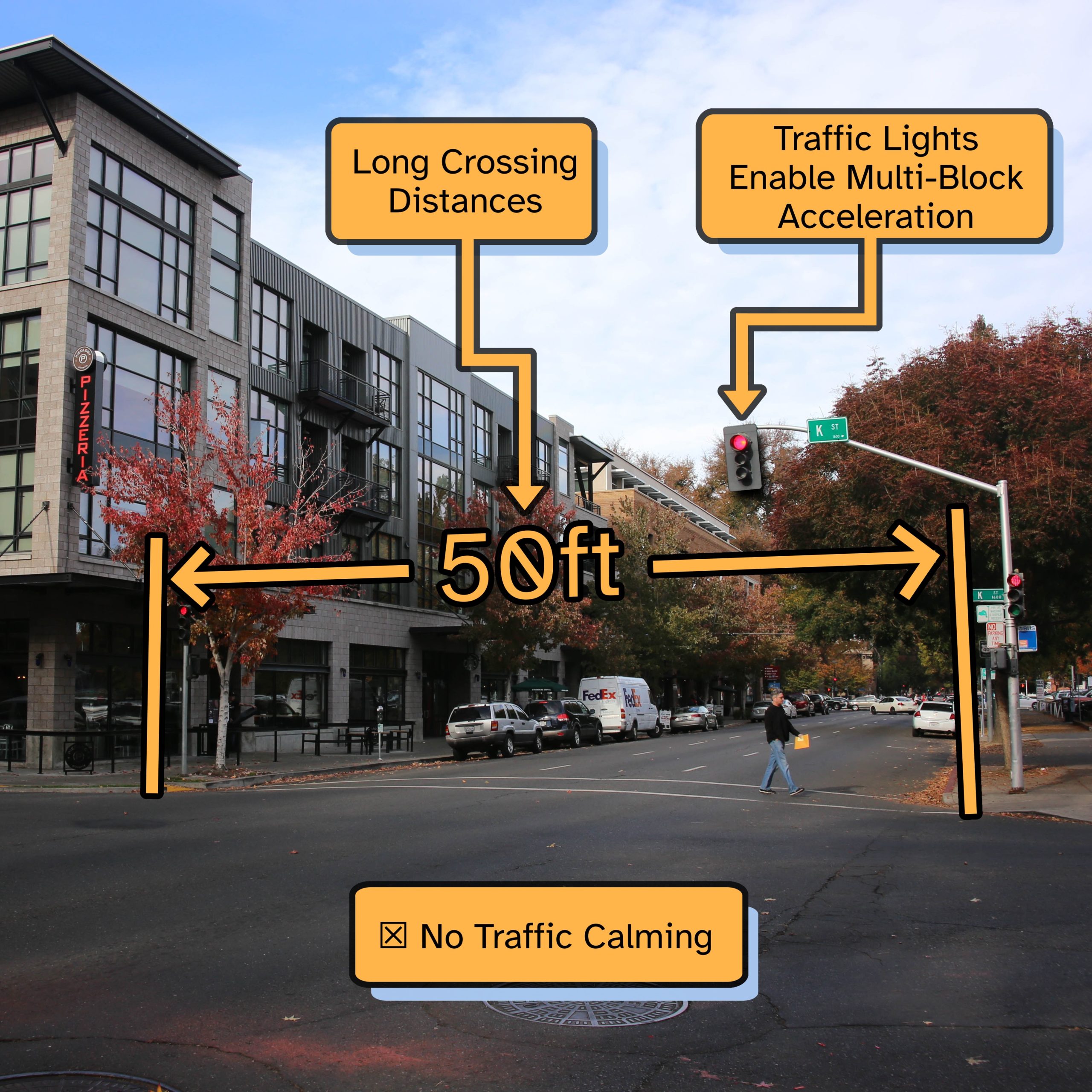
Photo: Paul Sableman
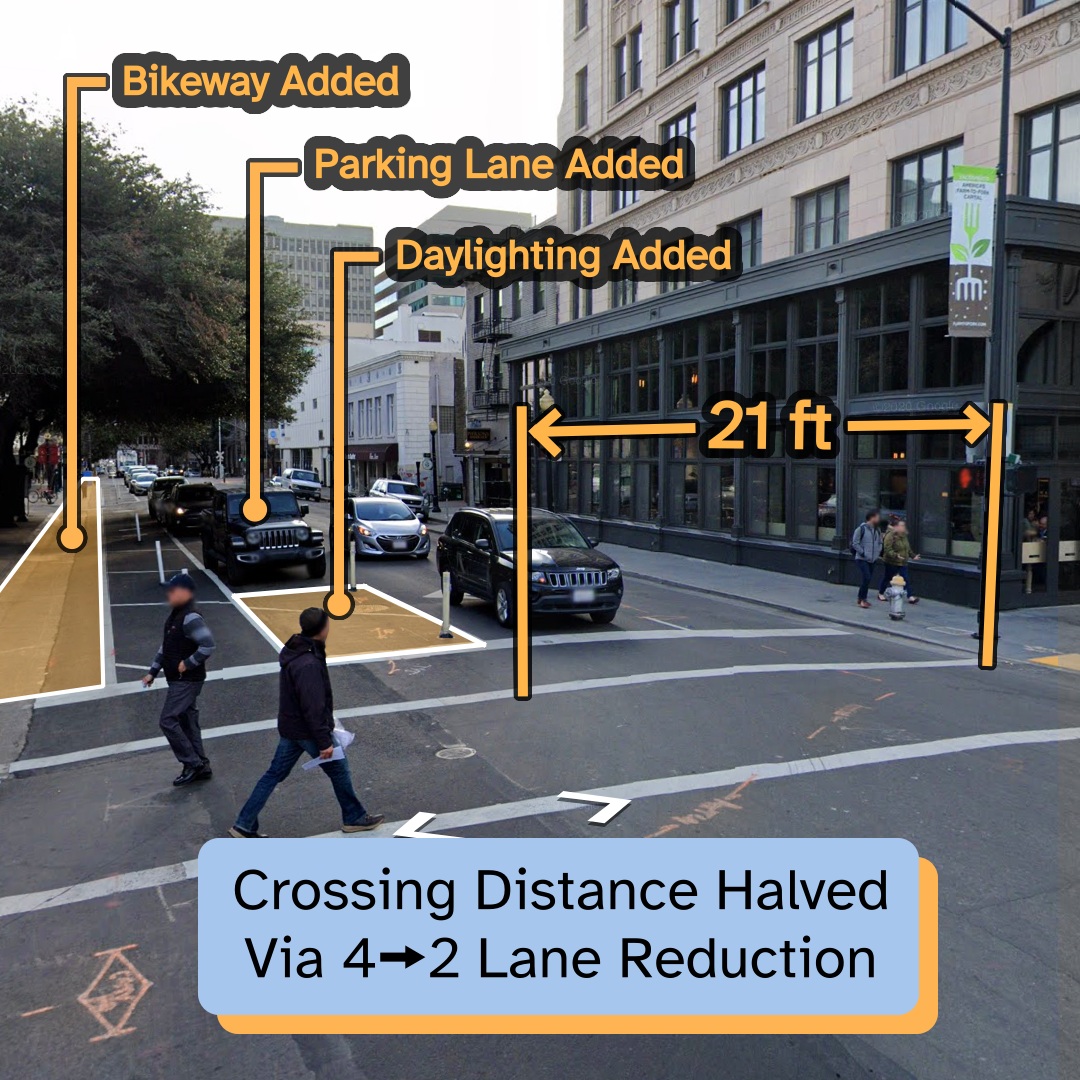
Photo: Google
Both are examples of one-way streets, but the latter is significantly safer than the former, and is likely to be quieter too. Perhaps more ambitious yet was the total reversion of E, F, G, and H streets from major one-way corridors into quiet, two-way, traffic-calmed neighborhood streets:
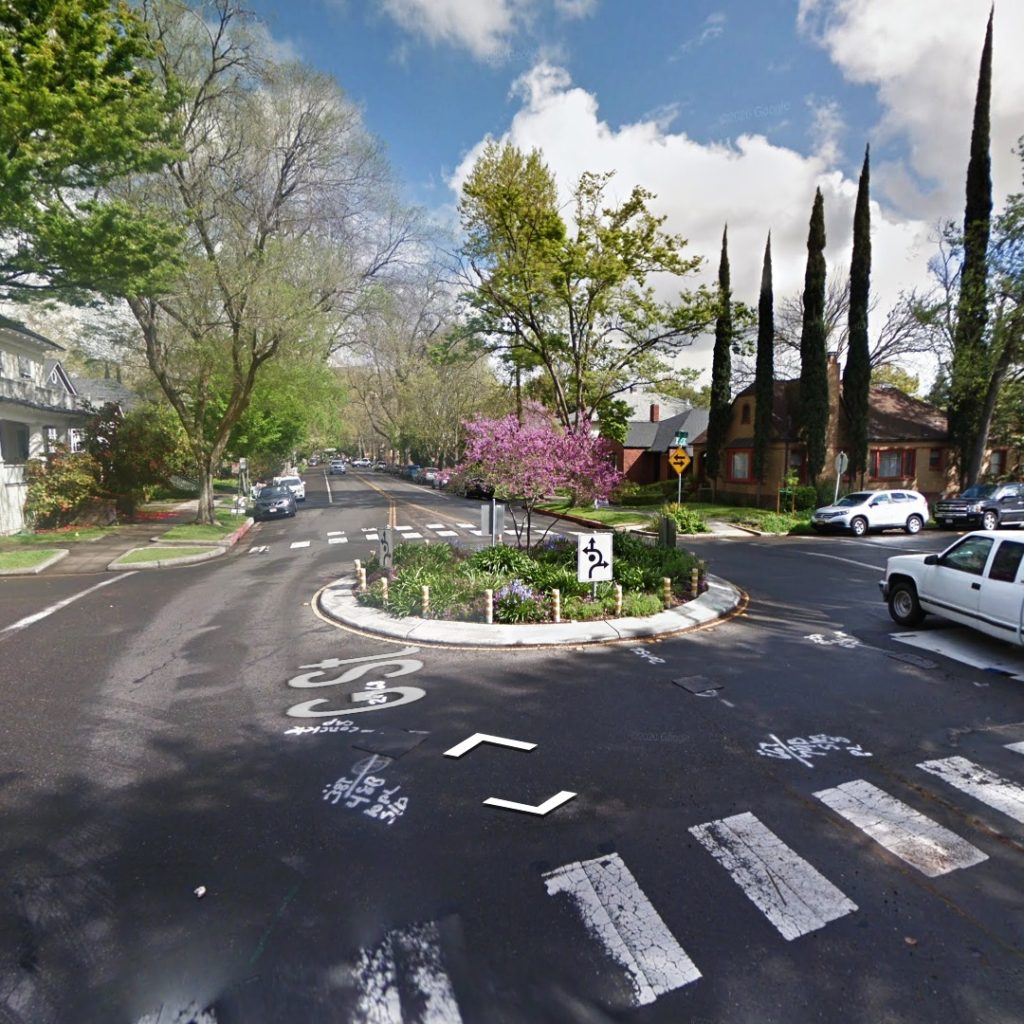
One-way streets may not be inherently dangerous, but they become dangerous when vehicle speed and capacity is prioritized in lieu of safety.
In response to public outcry about safety, traffic engineers often say, “A road diet won’t work” or “We don’t have room for a separated bike lane.” Without admitting it, the engineers are really saying “four lanes of traffic is a higher priority than safety.”
Conor Semler: A New Decision-Making Framework for Street Design | The Strong Towns Podcast
The Case Against High-Capacity Travel
If fast moving cars through a city are harmful and deadly, and the whole purpose of one-way streets is to move many cars quickly from the surrounding suburbs into the central city, then the Suburban Experiment is fundamentally incompatible with safe streets. Strong SacTown’s top priorities would significantly mitigate the need for high-capacity travel between any two neighborhoods:
- Incremental housing and mixed-use zoning locates people closer to their jobs and daily necessities. If applied citywide, this would result in a more uniform, mixed distribution of homes, workplaces, and 3rd places instead of segregating all land uses, keeping them driving-distance apart.
- Ending parking subsidies and mandates would discourage driving while simultaneously enabling more local and walkable development. Off-street parking alone eats up about 17-20% of the central city and adds 1 minute for every 5 minutes of walking.
- Transparent accounting helps the city and its constituents understand the true municipal and personal monetary cost of the Suburban Experiment and of building an entire city which forces most people to travel long distances for daily needs.
The more jobs and amenities we can add to today’s suburban neighborhoods, the fewer trips will be taken into downtown. Likewise, the more people that live in downtown, the more trips within downtown will be made by foot and bicycle.
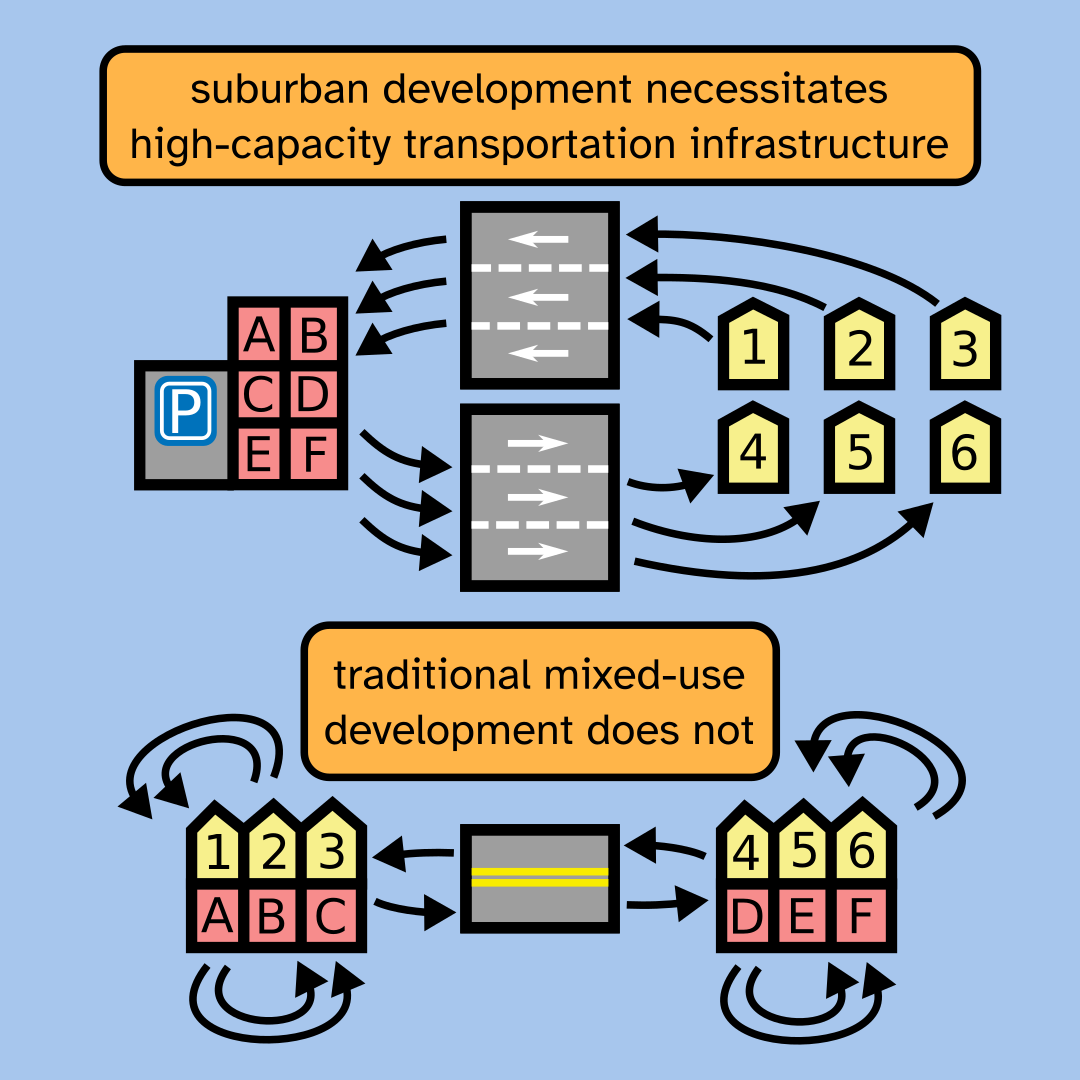
Transit zones outside the central city are ripe for these changes. Our Transit Oriented Development article outlines how there is significant potential to improve ridership by allowing development of high-density residences and jobs near light rail stations currently surrounded by parking lots and/or low-density suburbs.
The Future
Residents of the central city have come to discover the disadvantages of high-capacity one-way streets and have made great progress advocating for their removal or reduction. Today, this movement is gaining ever more traction. Going into 2024, I am confident we will be loud in shaping the new Central City Specific Plan and Sacramento Street Design Standards, both of which will play a critical role in the development of our streets.
